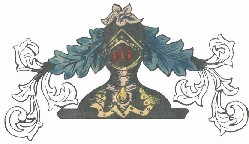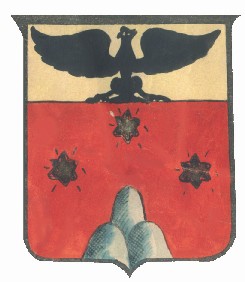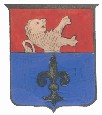|
Itinerary
: Langhe, Alba and Barolo
Piedmont:
north Italy
Description of the
itinerary
The hills of the Langhe
district south of Alba sketch out a helter-skelter route, uphill,
downhill, and round the bends that form the boundaries of Piedmont’s
finest vineyards. This is the kingdom of Barolo: wine of kings, king
of wines. Not that other important wines are lacking; Nebbiolo,
Dolcetto and Barbera, for example. Within the space of just a few
kilometres the route takes in all the most famous towns and hamlets of
the area, from Barolo itself to La Morra, from Monforte to Serralunga
d’Alba, in a succession of ancient estates and mediaeval towers
hidden in succession of fields and vineyards.
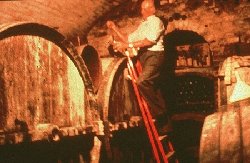
Wines:
Dolcetto d’Alba Verduno Pelaverga Barolo
Specialities:
Murazzano Robiola di Roccaverano Tajarin Tartufo d’Alba Torta di nocciole
Itinerary
in detail:
Alba | Roddi | Verduno | La Morra | Annunziata |
Barolo | Novello | Monforte d’Alba | Castiglione Falletto |
Serralunga d’Alba | Gallo | Grinzane Cavour
Alba,
capital of the Langhe
The obligatory starting point for any trip in the area is Alba, an
important agricultural and industrial centre, as well as a centre for
tourism. An ancient Roman settlement, the city as it is now was
largely built in mediaeval times and conserves its ancient shape in
the layout of its historic centre with its red-hued towers. This
alone, together with the charm of its busy shopping streets, makes the
city worth a visit. Start at Piazza Garibaldi, where there are the Law
Courts (Palazzo del Tribunale). Go down Via Cavour, with its mediaeval
towers and palazzi, until you reach Piazza del Duomo, home of both the
civil and religious authorities. The cathedral has magnificent works
of art from the sixteenth century and a wonderful inlayed-wood choir.
The imposing fifteenth-century bell tower is built around the remains
of an original Romanesque structure. The Town Hall (Palazzo del
Comune) is built on the remains of Roman walls. Alba’s town centre
radiates out from these buildings. An ancient, narrow street, full of
shops, Via Vittorio Emanuele, leads from Piazza del Duomo to Piazza
Savona, the lively commercial centre. This is a shopping paradise,
especially if you are looking for gourmet food and wine souvenirs. The
capital city of the Langhe holds several important festivals: Vinum (April/May)
- a fair dedicated to the great wines of Alba, the Langhe and Roero;
the Palio degli Asini (first Sunday of October) - a donkey race in the
historic city centre preceded by a sumptuous parade in period costume;
Fiera Nazionale del Tartufo di Alba (last three weeks of October) -
the Alba truffle festival, which attracts fans of this most precious
and expensive delicacy from all over the world.
The
royal castle at Verduno
Exit Alba using Corso Piave and turn right after
four kilometres towards Roddi, a fortified hilltop town dominated by
its XV century castle. Roddi is a charming mediaeval town, very
typical of the area, which owes its fame to a unique distinction: it
is the “university town” for truffle hounds. This is where dogs
come to learn how to sniff out buried truffles. Leave Roddi and
proceed towards the heart of the Langhe until Verduno , with its
pretty eighteenth-century castle. Built by the Marchesi Caisotti, it
was eventually sold with all its surrounding vineyards to King Carlo
Alberto of Savoy, who liked the wine of the region so much that he
decided to become a producer himself. Today the castle is in private
hands, but its vineyards continue to produce excellent wines. Besides
the production of Barolo and other traditional DOC wines, Verduno has
become important for the rediscovery of Pelaverga, an ancient local
grape producing an eponymous wine that has been pulled back from the
brink of extinction. Thanks to the efforts of local growers, a new DOC
for Pelaverga has now been approved and new vineyards are being
planted.
La
Morra: panoramic views over Piedmont
On past Verduno the road rises slightly to the
crest of a hill, making ever wider curves through ever more ample
vineyards on the approach to the heart of the Barolo region. After
about five kilometres comes La Morra, one of the most famous sub-zones
of Barolo. The town began life as a castle, until, in the XVI century,
the French occupying army forced its inhabitants to destroy it, on
pain of pillage and destruction. The order was carried out and today
the remains of the old ramparts are a place to walk, and admire a
fabulous panoramic view. Half Piedmont lies spread out in a succession
of hills and valleys, villages, castles, and watch towers. La Morra is
an ancient settlement, with many local finds dating back to the Romans.
But the most impressive signs of the past lie in its place names:
Costa Ungaresca recalls the depredations of the Hungarians in the year
1000 AD; Serra dei Turchi is a reminder of the Saracen invasions.
Annunziata
Leaving La Morra along the slope that crosses
the vineyards towards Gallo, the road leads to the district of
Annunziata, home of the Antiche Cantine dell’Abbazia
dell’Annunziata (Ancient Cellars of the Abbey of the Annunciation).
This is one of the most famous wineries of the region and produces a
range of wines including Barolo, Barbera d’Alba, Dolcetto d’Alba,
Campetto Colombè, and N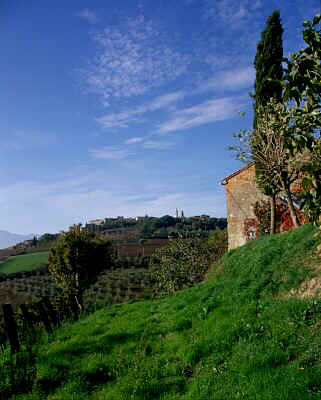 ebbiolo
d’Alba Ochetti di Monteu. Two new barrique-aged wines are worth
tasting as well: Cabernet I Cedri, and Villa Pattono, a blend of
Barbera and Freisa grapes. A fascinating small museum of wine-related
artefacts includes tools for use in the fields, wine-jars from down
the ages and documents about the history of the wines of Alba. ebbiolo
d’Alba Ochetti di Monteu. Two new barrique-aged wines are worth
tasting as well: Cabernet I Cedri, and Villa Pattono, a blend of
Barbera and Freisa grapes. A fascinating small museum of wine-related
artefacts includes tools for use in the fields, wine-jars from down
the ages and documents about the history of the wines of Alba.
Barolo
The town of Barolo lies at a lower elevation
than La Morra. The road runs towards the district of Vergne along a
ridgeback hill and then passes the ruins of the castle of Volta.
Slightly further on a fork in the road is signposted for Barolo.
Famous vineyards lie to the right and left, including some of the best
known cru sites, such as Cerequio, Sarmassa, Cannubi, and Brunate.
Houses cluster around the majestic castle that was once home to the
Marchesi Falletti. The history of Barolo began here when the wife of
Marchese Carlo Tancredi, the last of the Falletti, instructed French
oenologist, Louis Oudart, to overhaul the way wine was made on the
vast family estates. The experiment was so successful that King Carlo
Alberto himself asked the Marchesa for samples when he heard of it and
subsequently bought the castle and estates of Verduno to make some of
this wonderful Barolo wine himself.
Novello
and Monforte
Novello and Monforte d’Alba are the far
southern outposts of Barolo country. Novello , in fact, began life in
mediaeval times as a defensive outpost. There was once a castle
belonging to the Del Carretto family, where Marchese Manfredo was
murdered by his grandsons in 1340. Few traces remain nowadays, and
what is left was incorporated into a private house in the last century.
The village has a pretty eighteenth-century church exuding typical
Langhe peacefulness. From Novello the route doubles back on itself for
a while, following the signs for Monforte d’Alba. The name itself
reveals the strategic function of the settlement (Monte = hill; forte
= strong), and over the centuries it was frequently besieged in the
many conflicts between local lords and the town of Alba. Monforte’s
castle as seen now is of eighteenth-century origin. Some of the most
illustrious and world famous names in Italian winemaking have their
wineries in the territory of Monforte.
Castiglione
and Serralunga d’Alba
There are two ways to return to Alba from
Monforte, both keeping to Barolo country routes in the Langhe. The
first follows the descent to Castglione Falletto and Gallo with a more
tortuous and parallel road that runs via the Fontanafredda estate. The
second is slightly longer, but more scenic, and runs to the first
houses in Roddino where a lefthand turn leads to Serralunga d’Alba.
Vineyards are everywhere, whatever route is chosen. Just before
Serralunga, for example, the road crosses the celebrated Bricco Rocche
cru vineyard area belonging to the Ceretto brothers. It is worth
visiting Castiglione Falletto for the castle with its three corner
towers and a central keep, that once belonged to the family of the
Marchesi Falletti and still affords a view over other castles in the
area. More important is the nearby mediaeval castle of Serralunga
d’Alba, now publicly owned and open to visitors. The road runs down
the valley where a right turn leads immediately after a few hundred
metres to the extensive vineyards of the Tenimenti di Barolo e
Fontanafredda, and thence to Alba. The estate was founded in 1878 by
Count of Mirafiori and today belongs to a bank.
Grinzane
Cavour Castle
From Fontanafredda the road runs directly to
Alba, but just before the town goes through Gallo, famous for its
nougat production, and, then after a right turn quickly comes to
Grinzane Cavour , with its castle. Once the country residence of Count
Cavour, the famous statesman and Piedmontese politician (1810-1861),
the castle is now a museum dedicated to the wines and other products
of the Alba region. There are several rooms with memorabilia of Cavour
himself and information about truffles and the most important
handcraft activities of the area. From Grinzane take the road back to
nearby Alba. Just before a big bend, high up on the right, is the
attractive Villa Bernardina, right next to the Ceretto winery. A
little further on to the left is the modern building of the Colla
winery. At this point you are already back within city limits
|
